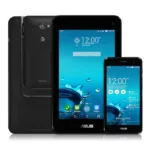One of the most interesting products I was connected to in the 1990s was the IBM modular computer. It was a brilliant idea it just was badly timed. A few years back Motorola tried to create a similar product with a smartphone that was nested in a thin client laptop like device called the Atrix but the OS wasn’t ready, the product cost as much as a smartphone and a tablet and the performance wasn’t great. Well Intel and Asus have partnered up and created a tablet/smartphone product and things are a lot different now. We could have a winner.
The IBM Modular Computer
For its time, in the late 1990s, this was really cool. At the time processors, storage, and memory were very expensive and were much of the cost of a $2K or $3K laptop computer. So the idea was to put the memory, storage, and processor into a small module and then sell accessories that would allow the module to be nested in a PDA case (this was before Smartphones), a tablet case, a laptop case and a desktop dock. The promise was that you’d only pay for the most expensive components once and you’d get the benefit of having your data on all of those device types. As technology advanced you’d only replace the obsolete component likely swapping out the core module often but rarely changing components.
There were four problems the first was that the cost of the core module’s components were dropping quickly, IBM was in a turnaround and the PC unit was still losing money, and at a low run the cost of the components wasn’t enough cheaper than full featured offerings. The fourth was that sync products were beginning to emerge making folks wonder if they really needed to move their data from device to device.
The product was licensed to a firm out of Europe that tried to make a market but they just didn’t have the resources and I was involved with a startup that wanted to do the same thing and we just couldn’t make the numbers work. This bounced around from others till around 2005 but the cost was insane the the performance really crappy.
As noted above Motorola tried this with a cell phone core and a laptop accessory but this was before the ChromeOS and Android which was struggling with tablets at the time wouldn’t scale well to a laptop form factor. Because they used a Smartphone as the core the economics looked better but even this aspect wasn’t where it needed to be.
The New Modular Computer
So the new device is called the PadFone X Mini and it costs $199 without an annual contract. Realize this is a blend between a Smartphone and a tablet making the cost, in line with a small tablet only device, pretty amazing. This is the first phone in the US with an Intel processor in it and the first product in its class from a recognized brand that both had good quality and an attractive price.
The specs are pretty impressive with around 15 hours of battery life for the phone alone and an additional 13 hours when the phone is docked in the table. Bracketing the Phablet phones at 4.5” for the phone component and 7” for the table you might choose to just use this docked and have one of the largest Phablets in the market and, if the size becomes a problem for your pockets, you just undock and carry the smaller device. Since the tablet and phone are one device data doesn’t have to be moved in order to move from the Tablet. It is supported by AT&T’s GoPhone non-subscription service which starts at $40 a month for both voice and data.
This product is actually an update of an earlier offering which ran the Snapdragon ARM processor but now it is running an Intel alternative and this one is contract free.
Wrapping Up: Windows?
Since this is now an x86 processor it begs the question of whether it will eventually run Windows 10 which is designed to scale from the Phones through tablets to PCs. That might be the ideal OS for a phone that can morph into other things like desktop computers because you’d get Office and productivity apps. So even though this version runs Android it seems obvious that Microsoft might want to embrace this design because they could likely do a better job with it.
In the end, at $200, this is one heck of a deal and if you want a no contract bargain this could be the biggest one in 2014. A tablet and a phone for the cost of a 7” tablet.
As a final note this could become a trend, there is an interesting Kickstarter project that takes this idea to the next logical step suggesting we could be at the beginning of a trend.








